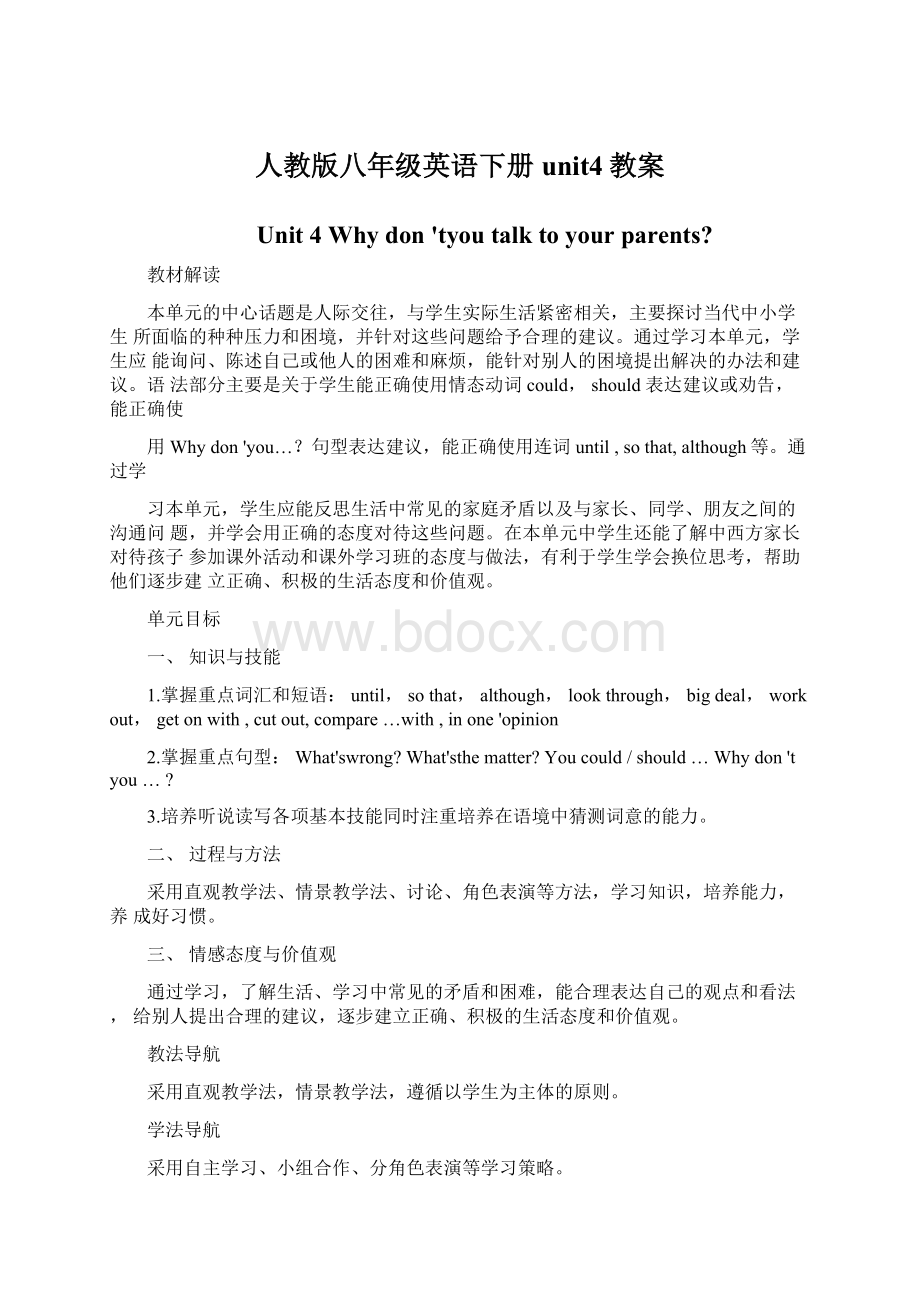人教版八年级英语下册unit4教案.docx
《人教版八年级英语下册unit4教案.docx》由会员分享,可在线阅读,更多相关《人教版八年级英语下册unit4教案.docx(16页珍藏版)》请在冰豆网上搜索。

人教版八年级英语下册unit4教案
Unit4Whydon'tyoutalktoyourparents?
教材解读
本单元的中心话题是人际交往,与学生实际生活紧密相关,主要探讨当代中小学生所面临的种种压力和困境,并针对这些问题给予合理的建议。
通过学习本单元,学生应能询问、陈述自己或他人的困难和麻烦,能针对别人的困境提出解决的办法和建议。
语法部分主要是关于学生能正确使用情态动词could,should表达建议或劝告,能正确使
用Whydon'you…?
句型表达建议,能正确使用连词until,sothat,although等。
通过学
习本单元,学生应能反思生活中常见的家庭矛盾以及与家长、同学、朋友之间的沟通问题,并学会用正确的态度对待这些问题。
在本单元中学生还能了解中西方家长对待孩子参加课外活动和课外学习班的态度与做法,有利于学生学会换位思考,帮助他们逐步建立正确、积极的生活态度和价值观。
单元目标
一、知识与技能
1.掌握重点词汇和短语:
until,sothat,although,lookthrough,bigdeal,workout,getonwith,cutout,compare…with,inone'opinion
2.掌握重点句型:
What'swrong?
What'sthematter?
Youcould/should…Whydon'tyou…?
3.培养听说读写各项基本技能同时注重培养在语境中猜测词意的能力。
二、过程与方法
采用直观教学法、情景教学法、讨论、角色表演等方法,学习知识,培养能力,养成好习惯。
三、情感态度与价值观
通过学习,了解生活、学习中常见的矛盾和困难,能合理表达自己的观点和看法,给别人提出合理的建议,逐步建立正确、积极的生活态度和价值观。
教法导航
采用直观教学法,情景教学法,遵循以学生为主体的原则。
学法导航
采用自主学习、小组合作、分角色表演等学习策略。
课时支配
第1课时:
SectionA1a-2d
第2课时:
SectionA3a-4c
第3课时:
SectionB1a-2e
第4课时:
SectionB3a-SelfCheck
课时教案
第1课时SectionA1a-2d
教学目标
一、知识与技能
1.能掌握以下单词:
allow,wrong,guess,deal,workout
2.能掌握以下句型:
1---What'swrong?
---I'mreylltriedbecauseIstudieduntilmidnightlastnight.
2Youcouldgivehimatickettoaballgame.
3Ithinkyoushouldaskyourparentsforsomemoney.
4Whydon'tyoutalktohimaboutit?
3.能了解以下语法:
1能够运用所学知识谈论问题和困难、提出建议并作出选择;
2能根据对方所提出的问题,给出一些合理的建议。
二、过程与方法
采用直观教学法,情景教学法,小组讨论与交流来了解生活中、学习中常见的矛盾与困难以及提出合理建议。
三、情感态度与价值观
培养学生良好的合作意识,鼓励学生大胆表达自己的想法和意愿。
正确认识生活中的一些困难,能采用正确的方式解决生活中的问题。
教学重点
掌握提建议的重点句型:
Youshould/could…Whydon'you…?
教学难点
能对别人的问题提出合理建议。
教法导航
直观教学法,情景教学法。
学法导航
独立思考,小组讨论,合作。
教学准备
图片,多媒体。
教学过程
Step1Greetings
Greetthestudentsasusual.
Step2Warmingup
Showsomepicturesandask:
What'sthematte/rWhat'swrong?
S:
Hehastoomuchhomeworktodo.
T:
Doesheliketodoit?
S1:
No,hedoesn't.Becausehedoesn'thaveanyfreetimetodothingshelikes.
Step3Talking
Say:
Inourdailylifetherearealwaysmanyproblems.Lookattheseproblems.Doyouthinktheyareseriousornot?
Studentsdiscusswiththeirpartnersandtrygivingsomeadvice.
1IhavetostudytoomuchsoIdon'tgetenoughsleep.
2IhavetoomuchhomeworksoIdon'thaveanyfreetimetodothingsIlike.
3Myparentsdon'tallowmetohangoutwithmyfriends.
4Ihavetoomanyafter-schoolclasses.
5Igotintoafightwithmybestfriend.
Step4Listening
T:
Tellstudentstoreadthesentencesin1aagain.Makesuretheyknowthemeaningofthesentences.Thenplaytherecordingforthestudentstolistenandcircletheproblemstheyhearin1a.Playtherecordingagain.Checktheanswerswiththestudents.
Step5Pairwork
Askapairofstudentstoreadtheconversationinthebox.ThenaskthestudentstoworkIpairsandusetheinformationin1atomakeotherconversations.Letsomepairsactouttheirconversations.
Step6Listening
2a,Say:
Peterhassomeproblems.Whatadvicedoeshisfriendgivehim?
Fillintheblankswithcouldorshould.Letstudentsreadthesentencesin2a.Playtherecordingforthestudentstolistenandwritethewordsintheblank.Playtherecordingagaintochecktheanswers.
2b,Letstudentsreadthesentencesbelow.Explainsomemainsentencesforthestudents.Makesuretheyknowthemeaningofeachsentence.Playtherecordingforthestudentstowritetheletters(a-e)nexttotheadvicein2a.Playtherecordingagaintochecktheanswers.
Step7Pairwork
Tellstudentstomakeaconversationusingtheinformationin2aand2b.Letonepairtoreadouttheirconversationfirst.
e.g.A:
What'sthematte,rPeter?
B:
Ihadafightwithmybestfriend.WhatshouldIdo?
A:
Well,youshouldcallhimsothatyoucansayyou'resorry.
B:
ButIdon'twanttotalkaboutitonthephone.
Studentsacttheconversationinpairs.Asksomepairstoactouttheirconversations.
Step8Role-play
Studentsreadtheconversationsandtrytounderstandthemeaning.Readtheconversationaftertheteacher.Practicetheconversationwiththeirpartner.Thenletsomepairs
toactouttheconversation.Explainsomenewwordsandmainpointsintheconversation.
1.bigdeal是英语中的一个固定搭配,表示“重要的事情或状况”,多用于非正式交流。
作否定用法时,常说It'snotabigdea或It'snobigdeal表示说话人并不认为某
thavetowatchit.It
事有什么了不起。
e.g.①There'sasoccergameonTVthiseveningbutIdondeal.
今天晚上电视上有一场足球赛,但我不一定要看。
没什么大不了的。
2It'sabigdealDavid,biggerthanyouknow.这事挺重要的,戴维,比你所知道的要重要。
2.workout解决(问题);算出
e.g.Mikeworkedoutthedifficultproblembyhimself.迈克自己算出了那道难题。
Step9Homework
Writethreeconversationsaboutyourproblemsandyourfriends'suggestions.
课堂作业
翻译短语和句子:
1.太多2.允许某人做某事3.闲逛4.给…打电话5.为了
6.浏览7.重要的事8.解决,算出9.怎么了?
10.你为什么不今天晚上早睡一会儿呢?
11.你应该给他打电话这样你就能向他道歉。
参考答案:
1.toomuch/toomany2.allowsb.todosth.3.hangout4.callup5.sothat6.lookthrough7.bigdeal8.workout9.What'swrong?
/